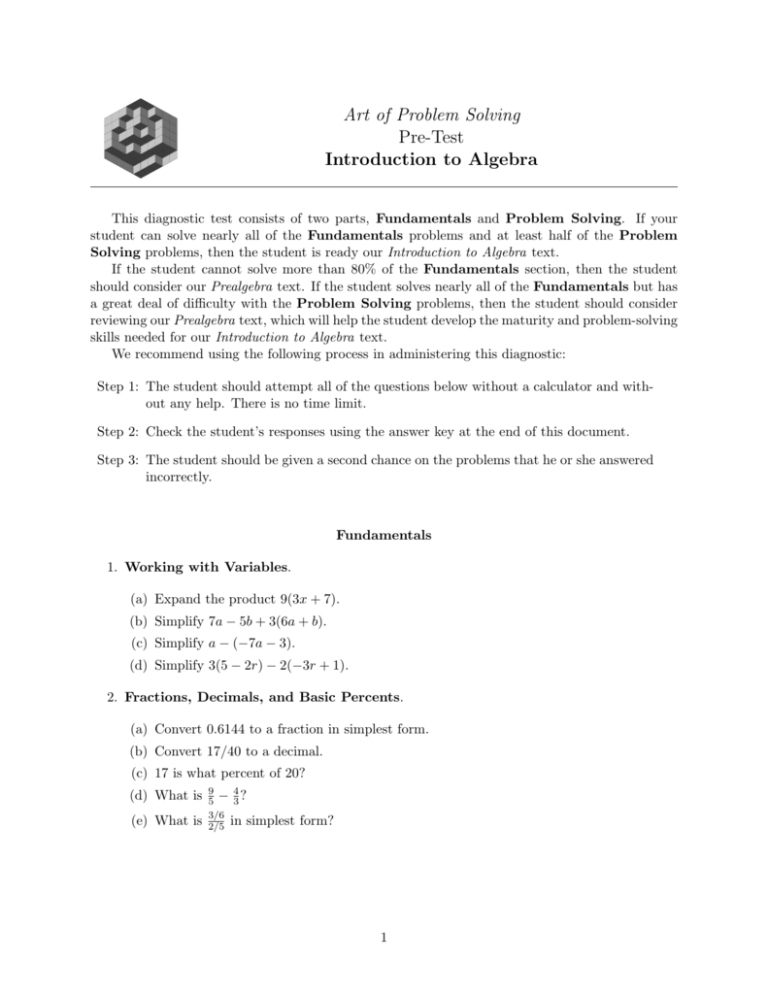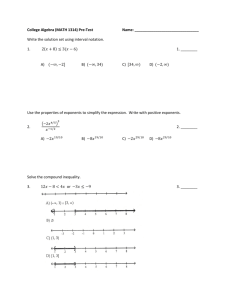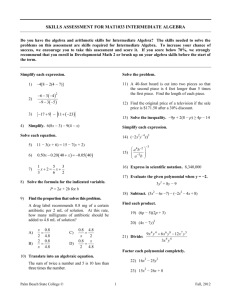
Art of Problem Solving
Pre-Test
Introduction to Algebra
This diagnostic test consists of two parts, Fundamentals and Problem Solving. If your
student can solve nearly all of the Fundamentals problems and at least half of the Problem
Solving problems, then the student is ready our Introduction to Algebra text.
If the student cannot solve more than 80% of the Fundamentals section, then the student
should consider our Prealgebra text. If the student solves nearly all of the Fundamentals but has
a great deal of difficulty with the Problem Solving problems, then the student should consider
reviewing our Prealgebra text, which will help the student develop the maturity and problem-solving
skills needed for our Introduction to Algebra text.
We recommend using the following process in administering this diagnostic:
Step 1: The student should attempt all of the questions below without a calculator and without any help. There is no time limit.
Step 2: Check the student’s responses using the answer key at the end of this document.
Step 3: The student should be given a second chance on the problems that he or she answered
incorrectly.
Fundamentals
1. Working with Variables.
(a) Expand the product 9(3x + 7).
(b) Simplify 7a − 5b + 3(6a + b).
(c) Simplify a − (−7a − 3).
(d) Simplify 3(5 − 2r) − 2(−3r + 1).
2. Fractions, Decimals, and Basic Percents.
(a) Convert 0.6144 to a fraction in simplest form.
(b) Convert 17/40 to a decimal.
(c) 17 is what percent of 20?
(d) What is
(e) What is
9
4
5 − 3?
3/6
2/5 in simplest
form?
1
Art of Problem Solving
Pre-Test
Introduction to Algebra
3. Linear Equations. Solve each of the following equations:
(a) 3r − 4 = 16 − 7r
(b)
2x − 3
4 − 3x
=
5
7
t
t
(c) 2 − = 3 5 −
4
6
4. Exponent Laws. Express each of the following as a power of 2:
(a) 27 · 26
(b)
213
25
(c) (24 )3
(d)
23
·
27
22
3
5. Ratio and Rates.
(a) The ratio of boys to girls at a summer camp is 4 to 5. If the total number of students
at the camp is 108, then how many boys are at the camp?
(b) The ratio of teachers to students in a particular school is 1 to 11. The ratio of female
students to the total number of students is 4 to 9. If there are 396 female students, then
how many teachers are there?
(c) A train is traveling 1 mile every 75 seconds. If the train continues at this rate, then how
far will it travel in two hours?
6. Square Roots. Simplify each of the following as much as possible:
r
√
√
7
(b) 144
(a) 81
(c)
1
9
2
√
108
(d) √
3
Art of Problem Solving
Pre-Test
Introduction to Algebra
Problem Solving
7. What is the value of the sum 5 + 10 + 15 + · · · + 95 + 100?
8. Two-fifths of the students in Central Middle School are boys. One-third of the girls have
blond hair and one-quarter of the boys have blond hair. What fraction of the students in
Central Middle School have blond hair?
1
9. Kayla adds the same number to both the numerator and denominator of the fraction 10
. Her
2
resulting fraction equals 3 . What number did she add to both the numerator and denominator
of her original fraction?
10. Five workers together can build a road in 20 days. Suppose every worker works at the same
rate. Three workers work on the road for 10 days before eleven more workers join them. How
much longer will it take the fourteen workers to finish the road?
11. In rectangle ABCD, point X is the midpoint of AD and Y is the midpoint of CD. What
fraction of the area of the rectangle is enclosed by 4AXY ?
12. At Annville Junior High School, 30% of the students in the Math Club are in the Science
Club, and 80% of the students in the Science Club are in the Math Club. There are 15
students in the Science Club. How many students are in the Math Club?
3
Art of Problem Solving
Pre-Test
Introduction to Algebra
The answers to the diagnostic Pre-Test are below. (The answers provided in the Introduction to
Algebra Solutions Manual include full detailed solutions as opposed to the mere answers provided
below.)
1. (a) 27x + 63; (b) 25a − 2b; (c) 8a + 3; (d) 13
2. (a) 384/625; (b) 0.425; (c) 85%; (d) 7/15; (e) 5/4
3. (a) r = 2; (b) x =
41
; (c) t = 52
29
4. (a) 213 ; (b) 28 ; (c) 212 ; (d) 218
5. (a) 48 boys; (b) 81 teachers; (c) 96 miles
6. (a) 9; (b) 12; (c)
4
3
or 1 13 ; (d) 6
7. 1050
8.
3
10
9. 17
10. 5 days
11.
1
8
12. 40
c 2012 AoPS Incorporated. All rights reserved.
4






